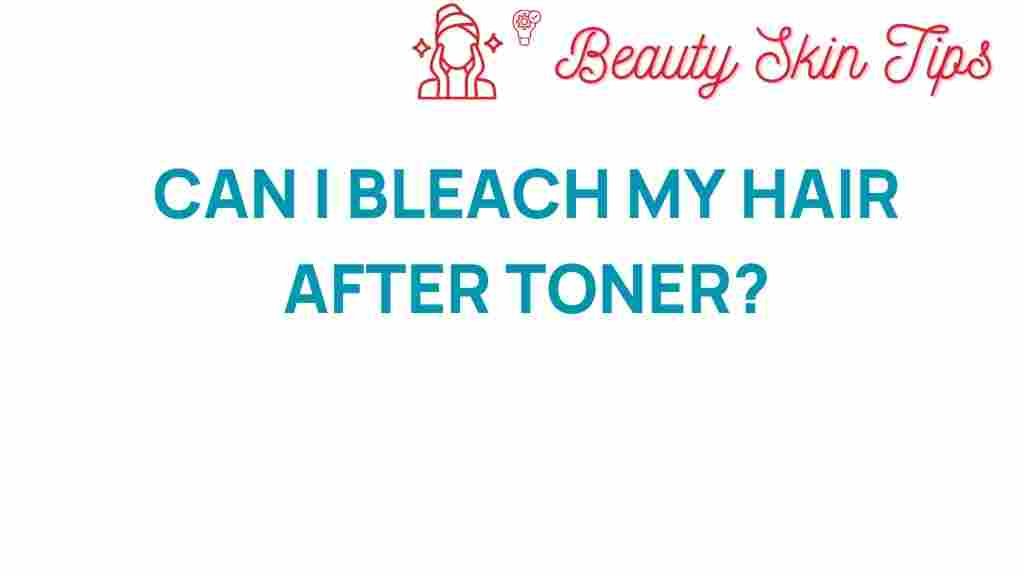The Surprising Truth: Can I Bleach My Hair After Toner?
If you’ve recently toned your hair and are contemplating whether to bleach it afterward, you’re not alone. Many individuals are curious about the effects of hair bleaching following toning. Understanding the relationship between these two processes is crucial for maintaining healthy hair and achieving your desired look. In this article, we delve into the details of hair bleaching after toner, providing you with insights, tips, and the best practices to follow.
Understanding Hair Bleaching and Toning
Before we dive into the specifics of whether you can bleach your hair after toner, it’s essential to understand what each process involves.
- Hair Bleaching: This process involves the use of chemical agents to strip the hair of its natural color. Bleaching raises the cuticle layer of the hair, allowing the bleach to penetrate and remove pigment. The result is a lighter hair color.
- Toning: Toning is often done after bleaching to neutralize unwanted brassy or yellow tones. Toners deposit color onto the hair, often in pastel or ash shades, to create a more balanced hue.
Now that we have a basic understanding of these processes, let’s explore whether you can safely bleach your hair after toning.
Can You Bleach Your Hair After Toning?
The short answer is yes, you can bleach your hair after toning. However, several factors must be considered to ensure that you do so safely and effectively.
Factors to Consider Before Bleaching After Toning
Before you proceed with hair bleaching after applying toner, consider the following:
- Hair Condition: Assess the health of your hair. If your hair is already damaged or brittle, bleaching it may exacerbate these issues.
- Time Span: Ideally, you should wait at least one to two weeks after toning before bleaching your hair. This waiting period allows your hair to recover from the toning process.
- Type of Toner Used: Different toners have varying effects on hair. Semi-permanent and temporary toners can usually be washed out more easily than permanent ones.
- Desired Result: Consider what you want to achieve with the bleach. If you’re looking for a significant change in color, you may need to adjust your approach.
Step-by-Step Process to Bleach Hair After Toning
If you decide to proceed with bleaching your hair after toning, follow these steps to ensure the best results:
Step 1: Gather Your Supplies
Make sure you have the following items on hand:
- Hair bleach (powder and developer)
- Protective gloves
- Applicator brush
- Mixing bowl
- Plastic wrap or shower cap
- Deep conditioner or hair mask
Step 2: Conduct a Strand Test
Before applying bleach to your entire head, perform a strand test. This will help you assess how your hair reacts to the bleach and the final color result.
Step 3: Prepare the Bleach
Follow the manufacturer’s instructions to mix the bleach powder with the developer in a mixing bowl until smooth.
Step 4: Apply the Bleach
Wearing gloves, section your hair and use the applicator brush to apply the bleach evenly, starting from the tips and working up to the roots. Be cautious not to overlap the bleach onto previously toned sections.
Step 5: Monitor Processing Time
Check your hair regularly while the bleach processes. Depending on your hair type and the desired lift, this could take anywhere from 20 to 45 minutes.
Step 6: Rinse and Condition
Once your hair has reached the desired lightness, rinse the bleach out thoroughly with cool water. Follow up with a deep conditioner to help restore moisture.
Post-Bleaching Care
After bleaching your hair, proper care is essential to maintain its health:
- Use Sulfate-Free Products: Opt for sulfate-free shampoos and conditioners to minimize damage.
- Deep Conditioning: Incorporate deep conditioning treatments into your hair care routine to maintain moisture levels.
- Avoid Heat Styling: Reduce the use of heat styling tools to prevent further damage.
Troubleshooting Common Issues
Even with careful preparation, you may encounter some challenges. Here are some common issues and how to troubleshoot them:
Brassy Tones
If you notice brassy tones after bleaching, consider using a purple shampoo to neutralize unwanted warmth.
Uneven Color
If your hair color appears uneven, it may be due to insufficient application. Ensure you apply bleach evenly, and consider a second application if necessary.
Dryness and Damage
To combat dryness, use hydrating hair masks and limit washing your hair to preserve natural oils.
When to Seek Professional Help
If you’re unsure about the bleaching process or have previously damaged hair, it may be best to seek the help of a professional stylist. They can assess your hair’s condition and recommend the best course of action.
For more information on hair care, check out this comprehensive guide.
Conclusion
In conclusion, you can indeed bleach your hair after toning, provided that you take the necessary precautions and care for your hair appropriately. Hair bleaching can be a transformative process, but it’s crucial to prioritize the health of your hair above all else. By following the steps outlined in this article and addressing any potential issues, you can achieve the light, vibrant hair color you desire.
Remember, patience is key. If you’re ever in doubt, consulting a professional stylist may be the best option to achieve your desired results safely.
For more tips on maintaining healthy hair, visit our resource page.
This article is in the category Treatments and created by BeautySkinTips Team
